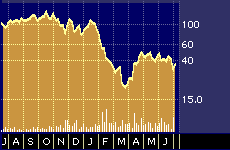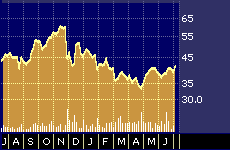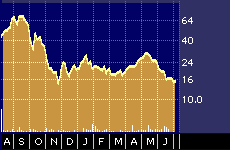
Fund Managers Say: Get Real!
Fund Managers Say: Get Real!
By Hal Plotkin
CNBC.com Silicon Valley Correspondent
Jul 13, 2001 03:43 PM
Sagging markets make this the time for investors to formulate more realistic long-term investment goals rather than shoot for the moon, according to participants at this week’s Franklin Templeton fund manager roundtable forum held in Silicon Valley.
Earlier this week, several Franklin Templeton fund managers met with a small group of press and analysts in connection with the firm’s grand opening of its sprawling new San Mateo, California headquarters. Despite recent setbacks in the market, the Franklin fund managers say they remain generally upbeat about the prospects for the market over the long-term, and at least a few carefully selected equities over the short term.
The current downturn has created what Franklin money managers say are some attractive individual stock buying opportunities. Although some of Franklin’s managers see signs of what they call a “stealth bull market” in the making, they quickly add, however, that investors should not expect anything like the returns they enjoyed during the late 1990’s, at least not for the foreseeable future.
“The bubble we experienced over the last few years is very likely to be something we never experience again in our lifetimes,” says Ian Link, portfolio manager of the $34 million dollar Franklin Technology Fund {FTCAX}. “But there are lots of opportunities getting washed over with all the other bad news.”
Link notes that last year spending on information technology accounted for 51 percent of all capital spending, up from roughly 5 percent in 1960.

Brocade Communications Inc. 52-week stock performance
“I think we’re going to see that trend continue over the next ten to twenty years,” he says. “You don’t get that kind of growth rate in any other industry.”
Link’s favorite picks at the moment, all of which are owned by his fund, include network data storage firm Brocade Communications Inc. {BRCD}, outsourcing firm Paychex Inc. {PAYX}, optical broadband supplier CIENA Corporation {CIEN} and power technology firm Active Power Inc. {ACPW}, among others.

Paychex Inc. 52-week stock performance
The common thread running though all his picks, says Link, is the potential for growth and share price appreciation created by leadership in business areas that are expected to outpace overall market averages.
Evan McCulloch, portfolio manager of the $1.09 billion dollar Franklin Biotechnology Discovery Fund {FBDIX}, singled out three firms, InterMune Pharmceuticals Inc. {ITMN}, Aviron Inc. {AVIR}, and BioMarin Pharmaceuticals Inc. {BMRN}, as his current top holdings in the sector. All three firms are expected to be nearing the introduction of important new drugs, he says.

CIENA Corporation 52-week stock performance
Aviron is working on a nasally administered flu vaccine, Biomarin Pharmaceutical is developing a treatment for the rare Hurler Scheie syndrome and InterMune is working on a cure for idiopathic pulmonary fibrosis, which afflicts 50,000 people in the U.S. alone.
Barring any unforeseen glitches, which are distressingly common in the biotech industry, all three firms are expected to bring their new compounds to market before the end of 2003, some sooner.
“A nasal spray flu vaccine will not only be more popular than injections,” he says. “It will also expand the limited supply of vaccine.”
Meanwhile, McCulloch says InterMune’s treatment for idiopathic pulmonary fibrosis, if approved by the FDA, is projected to cost roughly $50,000 per patient per year.

Active Power Inc. 52-week stock performance
“We have 350 biotech products on the market now and expect an additional 125 new products over the next three years,” he says. “This isn’t just about research anymore, it’s about products driving revenues.”
McCulloch, not surprisingly, says the best way to capitalize on such opportunities is through a diversified biotech mutual fund where losses associated with any one disappointment are balanced against gains elsewhere in the portfolio.
Terri Spath, portfolio manager of Franklin’s $63 million dollar Large Cap Growth Fund {FKGAX}, says she sees growing signs of what she calls a “stealth bull market” over the past few weeks.
As evidence, Spath points to recent figures from the National Association of Purchasing Managers that indicate an easing of the slump on the demand side. Throw in significant recent interest rate reductions and current valuation levels, she says, and you have the foundation in place for what should be a resurgent stock market.
Spath adds that it is “highly unusual” to see the overall market respond so tepidly to the recent string of interest rate reductions, which she predicts will nonetheless eventually work their traditional magic.
Large cap stocks appreciated an average of 25.5 percent between the beginning and end of the last eleven interest rate easing cycles, going back to 1954, according to Spath’s calculations.
“Monatary policy has proven in the past to be an admirable tool,” she says. “Large cap tech stocks are now back to their 20-year [P/E} average. Lower expectations are absolutely a virtue.”
Still, Spath concedes that she and her colleagues “spend a lot of time debating whether we are seeing the light at the end of the tunnel, or another oncoming train.”
For the record, though, Spath says she’s betting we’ve seen the last of the current investment cycle’s portfolio-flattening locomotives.
The $230 billion dollar strong Franklin Templeton family of funds was first established in 1947.


